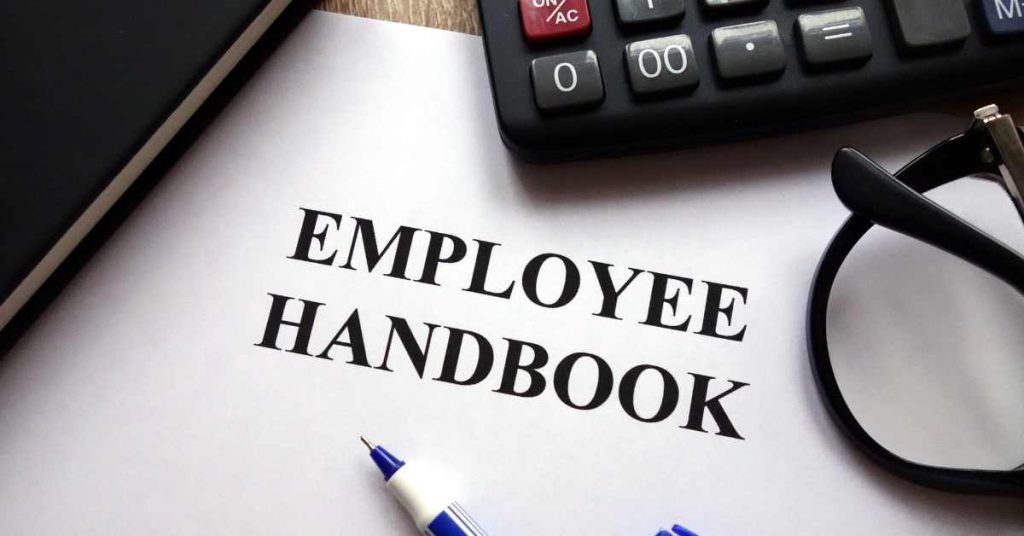What is an Employee Handbook?
An employee handbook is a company-issued document that serves as a comprehensive guide for employees about the organization’s policies, procedures, culture, and expectations. It informs employees about workplace rules, benefits, legal requirements, and company values, helping them understand what is expected of them and what they can expect from the company.
How to Create an Employee Handbook
To create an effective employee handbook:
- Start by outlining your company’s mission, history, and culture.
- Include all relevant policies covering employment terms, conduct, compensation, benefits, and legal compliance.
- Ensure the handbook is clear, concise, and accessible to all employees.
- Have it reviewed by legal experts to ensure compliance with federal, state, and local laws.
- Update the handbook regularly to reflect changes in company policy or law.
What to Consider Including in an Employee Handbook
Introduction and Overview
Provide a welcome message and an overview of what employees can expect from their employment experience, including company culture and values 58.
Conduct
Outline behavioral expectations, including codes of conduct, anti-harassment, and anti-discrimination policies19.
Employment Relationship
Clarify terms of employment such as at-will status, job classifications, and probationary periods9.
General Employment Information
Include work hours, attendance policies, dress code, and use of company property 59.
Attendance
Define expectations around punctuality, absences, and procedures for requesting time off.
Professionalism
Set standards for workplace behavior, communication, and interaction with colleagues and clients.
Compensation and Benefits
Explain pay schedules, overtime eligibility, bonuses, health insurance, retirement plans, and other benefits.
Time Off
Detail policies on vacation, sick leave, parental leave, and other types of paid or unpaid time off.
Acceptable Use
Describe acceptable use of company technology, social media, and confidentiality requirements.
Employee Monitoring
Inform employees about any monitoring of communications or activities as allowed by law and company policy1.
Performance Expectations
Explain how performance is evaluated, including review schedules and criteria.
Exit Policy
Outline procedures for resignation, termination, and return of company property.
Tips for Writing an Effective Employee Handbook
Write It Yourself
Tailor the handbook to your company’s unique culture and needs rather than relying solely on generic templates 6.
Have It Reviewed
Get legal review to ensure compliance and reduce risk of disputes.
Make It a Part of Onboarding
Introduce the handbook during new employee orientation to ensure understanding and compliance.
Obtain Signatures
Have employees acknowledge receipt and understanding of the handbook to protect the company legally.
Review It Regularly
Update the handbook to reflect changes in laws, company policies, or business practices.
Create a Digital Copy
Make the handbook accessible online for easy reference and updates.
Ensure It’s Readable
Use clear, concise language and an organized format to encourage employees to read and understand the content.
Include Disclaimers
Add disclaimers to clarify that the handbook is not a contract and that policies may change.
Employee Handbook Examples
Various companies provide examples of employee handbooks that include sections like mission statements, company history, policies, and procedures. These examples can serve as useful references when creating your own handbook.
Sample Employee Handbook for Small Businesses
1. History and Mission Statement
Provide background on the company’s founding and purpose.
2. Dress Code
Explain expectations for employee appearance and attire.
3. Duties
Outline job responsibilities and performance standards.
4. Supplies Requests
Describe procedures for requesting office supplies or equipment.
5. Paychecks
Detail payroll schedules, methods, and related policies.
6. Overtime
Explain eligibility and compensation for overtime work.
7. Time Off
Describe vacation, sick leave, and other leave policies.
8. Leftovers
Include any relevant policies on company property or resource use, such as leftover food or materials.
What is the Purpose of an Employee Handbook?
The purpose of an employee handbook is to clarify company policies, set clear expectations, promote consistency, and ensure legal compliance. It serves as a reference for employees and helps foster a positive and transparent workplace environment 9.
What Should Be in an Employee Handbook?
An effective employee handbook should include:
- Company mission, values, and culture
- Employment terms and conditions
- Workplace policies (attendance, conduct, dress code)
- Compensation and benefits details
- Leave and time-off policies
- Legal compliance statements (anti-discrimination, harassment)
- Performance and disciplinary procedures
- Safety and security guidelines
HR Pro Tip:
- Ensure the handbook is approved by legal counsel to avoid compliance issues.
- Encourage employee feedback and update the handbook as needed to keep it relevant and effective.
This comprehensive structure will help you create an employee handbook that is both practical and engaging, supporting your employees and protecting your organization.


